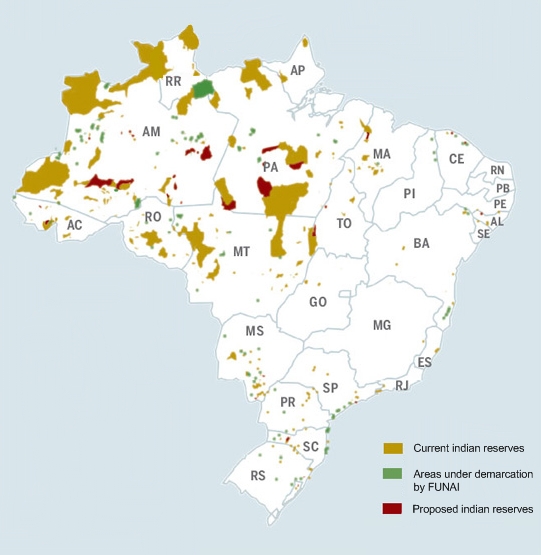|
Kayapó Indigenous Territory
The Kayapó Indigenous Territory ( pt, Terra Indígena Kayapó) is an indigenous territory located in Pará Pará is a state of Brazil, located in northern Brazil and traversed by the lower Amazon River. It borders the Brazilian states of Amapá, Maranhão, Tocantins, Mato Grosso, Amazonas and Roraima. To the northwest are the borders of Guyana ..., Brazil. Location The Kayapó Indigenous Territory has an area of . It is inhabited by the Kayapó people. As of 1990 Funai reported that the population was 1,946. In 2014 Siasi/Sesai reported that the population was 4,548. History The Kayapó Indigenous Territory was declared by decree 92.244 of 9 May 1985. The homologation was by decree 316 of 29 October 1991. References Sources * Kayapo people Uncontacted peoples Indigenous Territories (Brazil) Indigenous topics of the Amazon Protected areas established in 1991 1991 establishments in Brazil Protected areas of Pará {{Pará-geo-stub ... [...More Info...] [...Related Items...] OR: [Wikipedia] [Google] [Baidu] |
Indigenous Territory (Brazil)
In Brazil, an indigenous territory or indigenous land ( pt, Terra Indígena , TI) is an area inhabited and exclusively possessed by indigenous people. Article 231 of the Brazilian Constitution recognises the inalienable right of indigenous peoples to lands they "traditionally occupy"Defined as those lands "on which they live on a permanent basis, those used for their productive activities, those indispensable to the preservation of the environmental resources necessary for their well-being and for their physical and cultural reproduction, according to their uses, customs and traditions."Federal Constitution of BrazilChapter VII Article 231. and automatically confers them permanent possession of these lands. In practice, however, a multi-stage demarcation process is required for a TI to gain full protection, and this has often entailed protracted legal battles. Even after demarcation, TIs are frequently subject to illegal invasions by settlers and mining and logging companies. T ... [...More Info...] [...Related Items...] OR: [Wikipedia] [Google] [Baidu] |
FUNAI
is a Japanese consumer electronics company headquartered in Daitō, Osaka. Apart from producing its own branded electronic products, it is also an OEM providing assembled televisions and video players/recorders to major corporations such as Sharp, Toshiba, Denon, and others. Funai supplies inkjet printer hardware technology to Dell and Lexmark, and produces printers under the Kodak name. Its United States-based subsidiary Funai Corporation, Inc., based in Torrance, California, markets Funai products in the US, along with Funai-licensed brands including Philips, Magnavox, Emerson Radio, and Sanyo. Funai is the main supplier of electronics to Walmart and Sam's Club stores in the US, with production output in excess of 2 million flat-panel televisions during the summertime per year for Black Friday sale. History Funai was founded by Tetsuro Funai, the son of a sewing machine manufacturer. During the 1950s before the company was formed, Funai produced sewing machines and was one ... [...More Info...] [...Related Items...] OR: [Wikipedia] [Google] [Baidu] |
Pará
Pará is a Federative units of Brazil, state of Brazil, located in northern Brazil and traversed by the lower Amazon River. It borders the Brazilian states of Amapá, Maranhão, Tocantins (state), Tocantins, Mato Grosso, Amazonas (Brazilian state), Amazonas and Roraima. To the northwest are the borders of Guyana and Suriname, to the northeast of Pará is the Atlantic Ocean. The capital and largest city is Belém, which is located at the mouth of the Amazon. The state, which is home to 4.1% of the Brazilian population, is responsible for just 2.2% of the Brazilian GDP. Pará is the most populous state of the North Region, Brazil, North Region, with a population of over 8.6 million, being the ninth-most populous state in Brazil. It is the second-largest state of Brazil in area, at , second only to Amazonas (Brazilian state), Amazonas upriver. Its most famous icons are the Amazon River and the Amazon Rainforest. Pará produces Natural rubber, rubber (extracted from natural rubber tree ... [...More Info...] [...Related Items...] OR: [Wikipedia] [Google] [Baidu] |
Kayapó
The Kayapo (Portuguese: Caiapó ) people are the indigenous people in Brazil who inhabit a vast area spreading across the states of Pará and Mato Grosso, south of the Amazon River and along Xingu River and its tributaries. This pattern has given rise to the nickname the Xingu tribe. They are one of the various subgroups of the great Mebêngôkre nation (people from the water’s source). The term "Kayapo" is used by neighbouring groups rather than the Kayapo themselves. They refer to outsiders as "Poanjos". The type of sweet potato that forms an important part of the Kayapó diet is sometimes named "caiapo", after the tribe. It is cultivated under that name in Japan, and has been found to have health benefits. Location The Kayapo tribe lives alongside the Xingu River in the most east part of the Amazon Rainforest, in the Amazon basin, in several scattered villages ranging in population from one hundred to one thousand people in Brazil. Their land consists of tropical rainfores ... [...More Info...] [...Related Items...] OR: [Wikipedia] [Google] [Baidu] |
Homologation
Homologation (Greek ''homologeo'', ὁμολογέω, "to agree") is the granting of approval by an official authority. This may be a court of law, a government department, or an academic or professional body, any of which would normally work from a set of rules or standards to determine whether such approval should be given. The word may be considered very roughly synonymous with ''accreditation'', and in fact in French and Spanish may be used with regard to academic degrees (see apostille). ''Certification'' is another possible synonym, while ''to homologate'' is the infinitive verb form. In today's marketplace, for instance, products must often be homologated by some public agency to assure that they meet standards for such things as safety and environmental impact. A court action may also sometimes be homologated by a judicial authority before it can proceed, and the term has a precise legal meaning in the judicial codes of some countries. The equivalent process of testing ... [...More Info...] [...Related Items...] OR: [Wikipedia] [Google] [Baidu] |
Kayapo People
The Kayapo (Portuguese: Caiapó ) people are the indigenous people in Brazil who inhabit a vast area spreading across the states of Pará and Mato Grosso, south of the Amazon River and along Xingu River and its tributaries. This pattern has given rise to the nickname the Xingu tribe. They are one of the various subgroups of the great Mebêngôkre nation (people from the water’s source). The term "Kayapo" is used by neighbouring groups rather than the Kayapo themselves. They refer to outsiders as "Poanjos". The type of sweet potato that forms an important part of the Kayapó diet is sometimes named "caiapo", after the tribe. It is cultivated under that name in Japan, and has been found to have health benefits. Location The Kayapo tribe lives alongside the Xingu River in the most east part of the Amazon Rainforest, in the Amazon basin, in several scattered villages ranging in population from one hundred to one thousand people in Brazil. Their land consists of tropical rain ... [...More Info...] [...Related Items...] OR: [Wikipedia] [Google] [Baidu] |
Uncontacted Peoples
Uncontacted peoples are groups of indigenous peoples living without sustained contact with neighbouring communities and the world community. Groups who decide to remain uncontacted are referred to as indigenous peoples in voluntary isolation. Legal protections make estimating the total number of uncontacted tribes challenging, but estimates from the Inter-American Commission on Human Rights in the UN and the non-profit group Survival International point to between 100 and 200 tribes numbering up to 10,000 individuals.Report of the Regional Seminar on indigenous peoples in voluntary isolation and in initial contact of the Amazonian Basin and El Chaco, Santa Cruz de la Sierra, Bolivia (20–22 November 2006), presented by the Office of the United Nations High Commissioner for Human Rights (OHCHR) and the International Work Group on Indigenous Affairs (IWGIA), E/C.19/2007/CRP.1, March 28, 2007, para 1. A majority of tribes live in South America, particularly Brazil, where the Braz ... [...More Info...] [...Related Items...] OR: [Wikipedia] [Google] [Baidu] |
Indigenous Territories (Brazil) , area defined under a system of land management whereby traditional owners manage flora and fauna in protected areas of Australia
{{disambiguation ...
An indigenous territory is an area of land set aside for the use of indigenous peoples in a country that is largely populated by colonists from another region, typically Europe. The term may refer to *Indigenous territory (Brazil) ( pt, Terra indígena) * Indigenous territory (Bolivia) ( es, Territorio indígena originario campesinos) *Indigenous territory (Colombia) ( es, Territorio indígena) * Indigenous territory (Costa Rica) ( es, Territorio indígena) * Indigenous and community conserved area, a concept defined by the IUCN See also *Indigenous Protected Area An Indigenous Protected Area (IPA) is a class of protected area used in Australia; each is formed by voluntary agreement with Indigenous Australians, and declared by Aboriginal Australians and Torres Strait Islander representative organisations ... [...More Info...] [...Related Items...] OR: [Wikipedia] [Google] [Baidu] |
Indigenous Topics Of The Amazon
*
*
{{disambiguation ...
Indigenous may refer to: *Indigenous peoples *Indigenous (ecology), presence in a region as the result of only natural processes, with no human intervention *Indigenous (band), an American blues-rock band *Indigenous (horse), a Hong Kong racehorse * ''Indigenous'' (film), Australian, 2016 See also *Disappeared indigenous women *Indigenous Australians *Indigenous language *Indigenous religion *Indigenous peoples in Canada *Native (other) Native may refer to: People * Jus soli, citizenship by right of birth * Indigenous peoples, peoples with a set of specific rights based on their historical ties to a particular territory ** Native Americans (other) In arts and enterta ... [...More Info...] [...Related Items...] OR: [Wikipedia] [Google] [Baidu] |
Protected Areas Established In 1991
Protection is any measure taken to guard a thing against damage caused by outside forces. Protection can be provided to physical objects, including organisms, to systems, and to intangible things like civil and political rights. Although the mechanisms for providing protection vary widely, the basic meaning of the term remains the same. This is illustrated by an explanation found in a manual on electrical wiring: Some kind of protection is a characteristic of all life, as living things have evolved at least some protective mechanisms to counter damaging environmental phenomena, such as ultraviolet light. Biological membranes such as bark on trees and skin on animals offer protection from various threats, with skin playing a key role in protecting organisms against pathogens and excessive water loss. Additional structures like scales and hair offer further protection from the elements and from predators, with some animals having features such as spines or camouflage servin ... [...More Info...] [...Related Items...] OR: [Wikipedia] [Google] [Baidu] |
1991 Establishments In Brazil
File:1991 Events Collage.png, From left, clockwise: Boris Yeltsin, elected as Russia's first president, waves the new flag of Russia after the 1991 Soviet coup d'état attempt, orchestrated by Soviet hardliners; Mount Pinatubo erupts in the Philippines, making it the second-largest volcanic eruption of the 20th century; MTS Oceanos sinks off the coast of South Africa, but the crew notoriously abandons the vessel before the passengers are rescued; Dissolution of the Soviet Union: The Soviet flag is lowered from the Kremlin for the last time and replaced with the flag of the Russian Federation; The United States and soon-to-be dissolved Soviet Union sign the START I Treaty; A tropical cyclone strikes Bangladesh, killing nearly 140,000 people; Lauda Air Flight 004 crashes after one of its thrust reversers activates during the flight; A United States-led coalition initiates Operation Desert Storm to remove Iraq and Saddam Hussein from Kuwait, 300x300px, thumb rect 0 0 200 200 ... [...More Info...] [...Related Items...] OR: [Wikipedia] [Google] [Baidu] |






